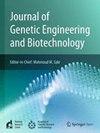利用响应面法优化工艺参数,提高枯草芽孢杆菌胆固醇氧化酶的产量。
IF 3.5
Q3 Biochemistry, Genetics and Molecular Biology
Journal of Genetic Engineering and Biotechnology
Pub Date : 2023-12-01
DOI:10.1186/s43141-023-00576-9
引用次数: 0
摘要
背景:胆固醇氧化酶有许多生物医学和工业应用。在本研究中,从污水中分离出一株新的细菌,并因其具有高胆固醇降解能力(%)和产生高胆固醇氧化酶活性(U/OD600)而被选中。结果:根据16S rRNA基因序列,鉴定该菌为枯草芽孢杆菌。通过分数析因设计(FFD)和响应面法(RSM)优化枯草芽孢杆菌胆固醇降解率(%)和胆固醇氧化酶(U/OD600)活性的发酵条件。根据该顺序优化方法,将胆固醇浓度、接种量和硫酸镁浓度分别设置为0.05 g/l、6%和0.05 g/l时,胆固醇降解率为80.152%。在初始pH = 6时,调节发酵条件可获得85.461 U的胆固醇氧化酶/OD600;发酵培养基体积,15ml /烧瓶;胆固醇浓度0.05 g/l。优化后的工艺使其胆固醇降解率(%)和胆固醇氧化酶(U/OD600)活性分别提高139%和154%。通过气相色谱-质谱联用(GC-MS)对优化的发酵培养基进行光谱分析,未检测到胆固醇。结论:本研究为枯草芽孢杆菌高效生产胆固醇氧化酶的研究提供了重要依据。本文章由计算机程序翻译,如有差异,请以英文原文为准。
Improved production of Bacillus subtilis cholesterol oxidase by optimization of process parameters using response surface methodology
Background
Cholesterol oxidase has numerous biomedical and industrial applications. In the current study, a new bacterial strain was isolated from sewage and was selected for its high potency for cholesterol degradation (%) and production of high cholesterol oxidase activity (U/OD600).
Results
Based on the sequence of 16S rRNA gene, the bacterium was identified as Bacillus subtilis. The fermentation conditions affecting cholesterol degradation (%) and the activity of cholesterol oxidase (U/OD600) of B. subtilis were optimized through fractional factorial design (FFD) and response surface methodology (RSM). According to this sequential optimization approach, 80.152% cholesterol degradation was achieved by setting the concentrations of cholesterol, inoculum size, and magnesium sulphate at 0.05 g/l, 6%, and 0.05 g/l, respectively. Moreover, 85.461 U of cholesterol oxidase/OD600 were attained by adjusting the fermentation conditions at initial pH, 6; volume of the fermentation medium, 15 ml/flask; and concentration of cholesterol, 0.05 g/l. The optimization process improved cholesterol degradation (%) and the activity of cholesterol oxidase (U/OD600) by 139% and 154%, respectively. No cholesterol was detected in the spectroscopic analysis of the optimized fermented medium via gas chromatography-mass spectroscopy (GC–MS).
Conclusion
The current study provides principal information for the development of efficient production of cholesterol oxidase by B. subtilis that could be used in various applications.
求助全文
通过发布文献求助,成功后即可免费获取论文全文。
去求助
来源期刊

Journal of Genetic Engineering and Biotechnology
Biochemistry, Genetics and Molecular Biology-Biotechnology
CiteScore
5.70
自引率
5.70%
发文量
159
审稿时长
16 weeks
期刊介绍:
Journal of genetic engineering and biotechnology is devoted to rapid publication of full-length research papers that leads to significant contribution in advancing knowledge in genetic engineering and biotechnology and provide novel perspectives in this research area. JGEB includes all major themes related to genetic engineering and recombinant DNA. The area of interest of JGEB includes but not restricted to: •Plant genetics •Animal genetics •Bacterial enzymes •Agricultural Biotechnology, •Biochemistry, •Biophysics, •Bioinformatics, •Environmental Biotechnology, •Industrial Biotechnology, •Microbial biotechnology, •Medical Biotechnology, •Bioenergy, Biosafety, •Biosecurity, •Bioethics, •GMOS, •Genomic, •Proteomic JGEB accepts
 求助内容:
求助内容: 应助结果提醒方式:
应助结果提醒方式:


